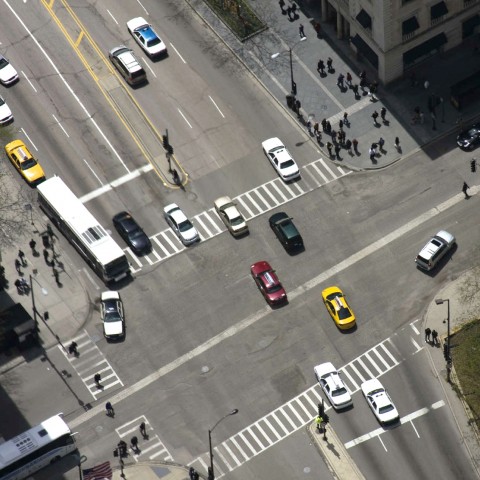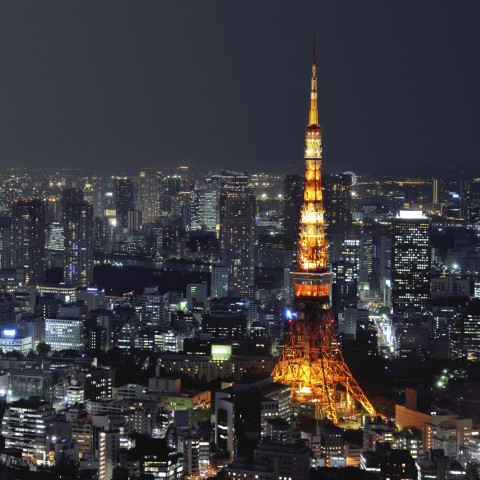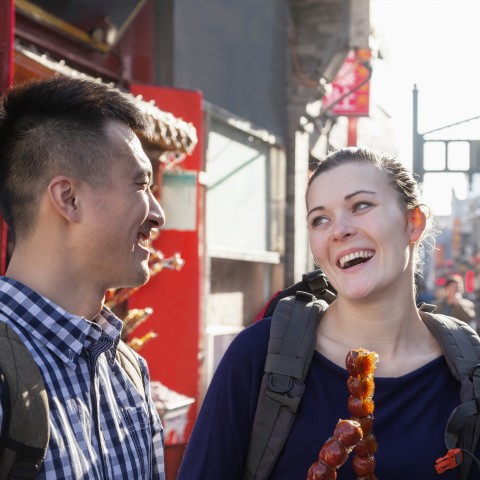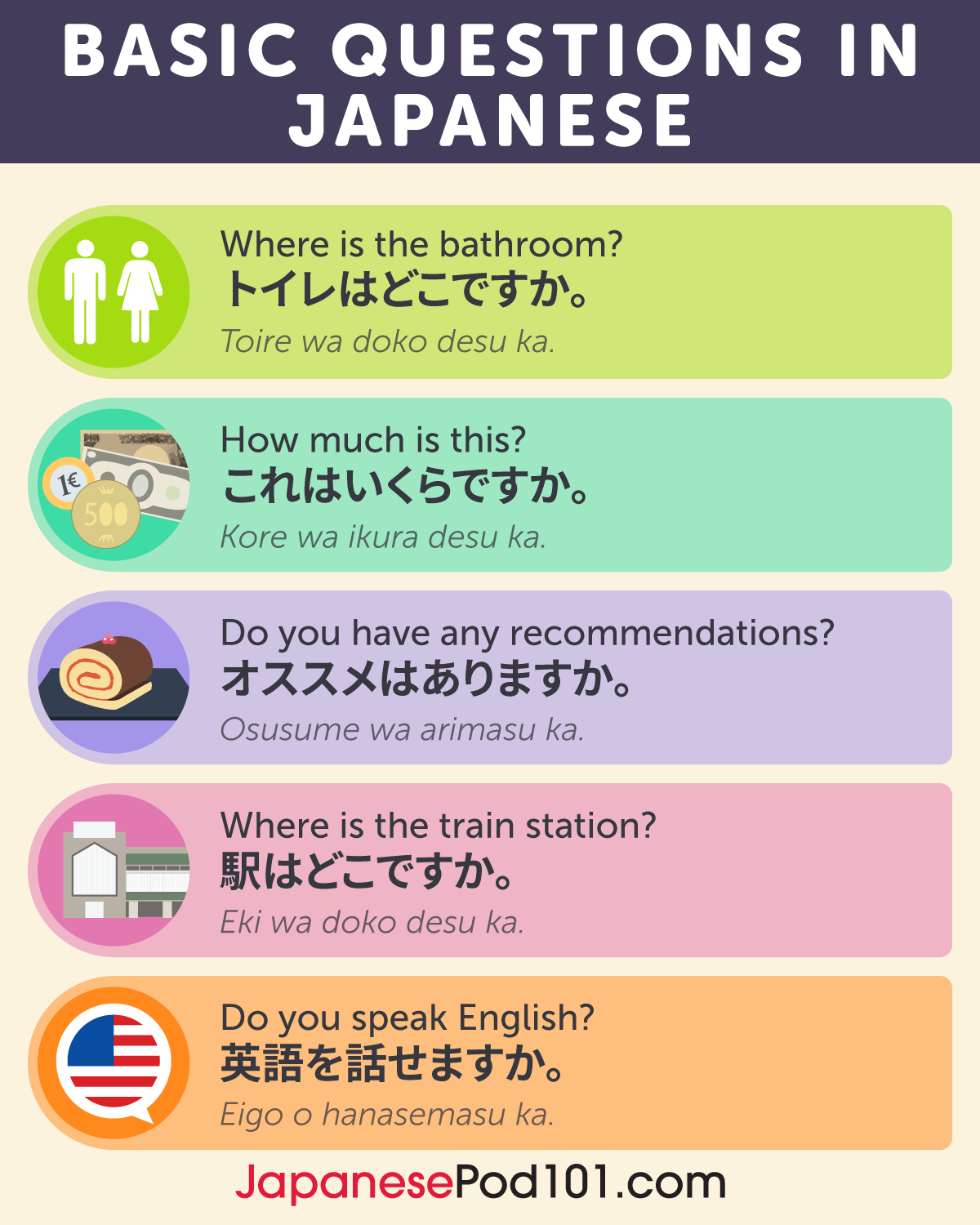
Knowing how to ask for directions in Japanese is very helpful when it comes to getting around in Japan. In particular, finding the right address can be a bit confusing, because smaller streets in Japan aren’t named and addresses are expressed with the name of a small area and numbers.
Along with knowing how to ask directions in Japanese, understanding the directions you were told is even more important. This ensures that you can reach the destination with the information given. (You don’t want to mistake “right” in Japanese for left!)
But don’t worry! Japanese people are kind in general, and they’ll stop to listen and help you when you ask them for directions in Japanese.
Here’s some useful vocabulary and phrases for giving and asking for directions in Japanese. Master directions in Japanese at JapanesePod101.com and find your way to exciting destinations!

Table of Contents
- On the Map: Cardinal Directions in Japanese
- On the Road
- Giving Directions in Japanese Using Landmarks
- Must-Know Phrases for Asking for Directions in Japanese
- Must-Know Phrases for Giving Directions in Japanese
- Other Useful Phrases for Asking Directions with Map/Phone
- Conclusion: How JapanesePod101 Can Help You Learn More Japanese
1. On the Map: Cardinal Directions in Japanese

Let’s master the basic compass directions in Japanese for reading the map.
1- Basic Vocabulary
| Reading | Kanji | Hiragana | English |
| kita | 北 | きた | north |
| minami | 南 | みなみ | south |
| nishi | 西 | にし | west |
| higashi | 東 | ひがし | east |
| hokusei | 北西 | ほくせい | northwest |
| hokutō | 北東 | ほくとう | northeast |
| nantō | 南東 | なんとう | southeast |
| nansei | 南西 | なんせい | southwest |
| chizu | 地図 | ちず | map |
| genzaichi | 現在地 | げんざいち | current location |
2- Examples
- 皇居は現在地から北東へ5kmの場所にあります。
Kōkyo wa genzaichi kara hokutō e go-kiromētoru no basho ni arimasu.
The Imperial Palace is located 5km northeast from the current location. - 日本の地理は、北の北海道、東の関東、西の関西、南の九州が特徴です。
Nihon no chiri wa, kita no Hokkaidō, higashi no Kantō, nishi no Kansai, minami no Kyūshū ga tokuchō desu.
The geography of Japan is characterized by Hokkaidō of the North, Kantō of the East, Kansai of the West, and Kyūshū of the south. - 横浜は、東京の南に位置しています。
Yokohama wa Tōkyō no minami ni ichi shite imasu.
Yokohama is located in the south of Tokyo.
 The Japanese map shows the major roads with names, but small streets don’t have names. It’s useful to know the word kita, meaning “north” in Japanese, for reading the map.
The Japanese map shows the major roads with names, but small streets don’t have names. It’s useful to know the word kita, meaning “north” in Japanese, for reading the map.
2. On the Road
Knowing how to say directions in Japanese for the road, such as right and left in Japanese, is very useful. The vocabulary below is essential for giving and receiving driving directions in Japanese!1- Basic Vocabulary
| Reading | Kanji | Hiragana | English |
| mae | 前 | まえ | front |
| ushiro | 後ろ | うしろ | back |
| hidari | 左 | ひだり | left |
| migi | 右 | みぎ | right |
| tōi | 遠い | とおい | far |
| chikai | 近い | ちかい | close |
| koko | ー | ここ | here |
| asoko | ー | あそこ | there |
| massugu | ー | まっすぐ | straight |
| tonari | 隣 | となり | next |
| watatta | 渡った | わたった | across |
| kōsaten | 交差点 | こうさてん | intersection |
| kado o magaru | 角を曲がる | かどをまがる | turn the corner |
2- Examples
- 東京タワーは東京プリンスホテルの隣にあります。次の角を右に曲がって、まっすぐ進んでください。
Tōkyō Tawā wa Tōkyō Prince Hotel no tonari ni arimasu. Tsugi no kado o migi ni magatte, massugu susunde kudasai.
Tokyo Tower is located next to Tokyo Prince Hotel. Please turn right at the next corner and go straight. - 明治神宮は原宿駅から200mくらいの場所で、近いです。
Meiji Jingū wa Harajuku Eki kara ni-hyaku-mētoru kurai no basho de, chikai desu.
Meiji Jingū is located around 200m away from Harajuku Station and it is close. - 都庁のビルは、新宿中央公園から交差点を渡った場所にあります。
Tochō no biru wa, Shinjuku Chūō Kōen kara kōsaten o watatta basho ni arimasu.
The Tokyo Metropolitan Government Building is located across the intersection from Shinjuku Central Park. - あそこの交差点を左に曲がって道をまっすぐ行くと、前に駅が見えます。
Asoko no kōsaten o hidari ni magatte michi o massugu iku to, mae ni eki ga miemasu.
When you turn left at the intersection there, go straight on the street; you will see the station in front.

When you’re at an intersection or on a road, migi, meaning “right” in Japanese, and hidari, meaning “left” in Japanese, are essential words to use for giving/asking directions.
3. Giving Directions in Japanese Using Landmarks
A landmark is an object or feature of a landscape or city that’s easily seen and recognized from a distance. Know the basic vocabulary for landmarks will help you understand when you’re getting directions in Japanese.
1- In the City: Basic Vocabulary
| Reading | Kanji | Hiragana / Katakana | English |
| kūkō | 空港 | くうこう | airport |
| chikatetsu no ek | 地下鉄の駅 | ちかてつのえき | subway station |
| machi no chūshinchi | 街の中心地 | まちのちゅうしんち | center of the city |
| kōen | 公園 | こうえん | park |
| hoteru | ー | ホテル | hotel |
| byōin | 病院 | びょういん | hospital |
| ginkō | 銀行 | ぎんこう | bank |
Examples
- 地下鉄の駅は、この道をまっすぐ進むと、銀行の隣にあります。
Chikatetsu no eki wa, kono michi o massugu susumu to, ginkō no tonari ni arimasu.
The subway station is located next to the bank when you go straight on this road. - この街の中心地は駅の近くで、あそこの病院を右に曲がって500mくらいの場所にあります。
Kono machi no chūshinchi wa eki no chikaku de, asoko no byōin o migi ni magatte go-hyaku-mētoru kurai no basho ni arimasu.
The center of this city is located near the station, and it’s 500m away after you turn right at the hospital there. - この交差点を左に曲がると、地下鉄の駅があります。
Kono kōsaten o hidari ni magaru to, chikatetsu no eki ga arimasu.
When you turn left at this intersection, the subway station is there.
2- On the Road: Basic Vocabulary
| Reading | Kanji | Hiragana / Katakana | English |
| shingō | 信号 | しんごう | traffic light |
| ōdanhodō | 横断歩道 | おうだんほどう | crosswalk |
| kado | 角 | かど | corner |
| tatemono / biru | 建物 / ビル | たてもの / ビル | building |
| kōban / keisatsusho | 交番 / 警察署 | こうばん / けいさつしょ | police station |
| eki | 駅 | えき | train station |
| basutei | バス停 | バスてい | bus stop |
| hashi | 橋 | はし | bridge |
A 交番 こうばん (kōban) is a small police station in a community, and is the smallest unit of the police structure in Japan. On the other hand, a 警察署 けいさつしょ (keisatsusho) is a large police station which is usually the headquarters of the police station in a city or area.
Examples
- 駅は、あの横断歩道を渡って右にある高い建物の後ろにあります。
Eki wa, ano ōdanhodō o watatte migi ni aru takai tatemono no ushiro ni arimasu.
The train station is located at the back of the tall building on the right after crossing that crosswalk. - この道をまっすぐ進むと、左に交番が見えます。交番の角を右に曲がるとバス停があります。
Kono michi o massugu susumu to, hidari ni kōban ga miemasu. Kōban no kado o migi ni magaru to basutei ga arimasu.
When you go straight on this street, you will see the police station on your left. There is the bus stop after you turn right at the corner of the police station. - あの橋を渡って見える大きい建物は横浜ホテルです。
Ano hashi o watatte mieru ōkii tatemono wa Yokohama Hotel desu.
The big building you see across that bridge is Yokohama Hotel.
 Tokyo Tower is one of the most famous landmarks in Tokyo.
Tokyo Tower is one of the most famous landmarks in Tokyo.
3- In a Structure/Building: Basic Vocabulary
| Reading | Kanji | Hiragana / Katakana | English |
| iriguchi | 入口 | いりぐち | entrance |
| deguchi | 出口 | でぐち | exit |
| keshōshitsu / toire | 化粧室 / トイレ | けしょうしつ / トイレ | restroom |
| kaidan | 階段 | 階段 | stairs |
| erebētā | ー | エレベーター | elevator |
| mon | 門 | もん | gate |
| chūshajō | 駐車場 | ちゅうしゃじょう | parking lot |
Examples
- 地下鉄の駅の入口は、この階段を降りた右側にあります。
Chikatetsu no eki no iriguchi wa, kono kaidan o orita migigawa ni arimasu.
The entrance of the subway station is located at the right side after going down the stairs. - トイレはこのビルの3階にあります。あのエレベーターで3階に行けます。
Toire wa kono biru no san-kai ni arimasu. Ano erebētā de san-kai ni ikemasu.
There is a toilet on the third floor in this building. You can go to the third floor with that elevator. - あの駐車場の門の隣に出口があります。
Anochūshajō no mon no tonari ni deguchi ga arimasu.
There is an exit next to that gate in the parking lot.
 There are many exit gates in the large stations in Japan’s larger cities.
There are many exit gates in the large stations in Japan’s larger cities.
4. Must-Know Phrases for Asking for Directions in Japanese

Here’s a list of useful phrases and examples for how to ask for directions in Japanese.
1- Polite Phrases to Begin Your Question
すみません (sumimasen) — Excuse me
すみません、この駅の入口はどこですか。Sumimasen, kono eki no iriguchi wa doko desu ka.
Excuse me, where is the entrance to this station?
ちょっといいですか。(Chotto ii desu ka.) — Can I talk to you? / May I ask a bit?
ちょっといいですか。渋谷駅はどこですか。Chotto ii desu ka. Shibuya Eki wa doko desu ka.
Can I talk to you a bit? Where is Shibuya station?
助けてもらえますか。(Tasukete moraemasu ka.) — Will you help me?
助けてもらえますか。空港までの行き方を教えてくれませんか。Tasukete moraemasu ka. Kūkō made no ikikata o oshiete kuremasen ka.
Will you help me? Can you show me the way to go to the airport?
2- Example Phrases Using “Where is…?”
…はどこですか。(… wa doko desu ka.) — Where is …?
- すみません、トイレはどこですか。
Sumimasen, toire wa doko desu ka.
Excuse me, where is the toilet? - ちょっといいですか。代々木公園はどこですか。
Chotto ii desu ka. Yoyogi Kōen wa doko desu ka.
Can I talk to you? Where is Yoyogi Park? - すみません、お台場はどこですか。
Sumimasen, Odaiba wa doko desu ka.
Excuse me, where is Odaiba?
3- Example Phrases Using “How do I get to…?”
…にはどうやって行けばいいですか。 (… ni wa dō yatte ikeba ii desu ka.) — How do I get to…?
- 浅草にはどうやって行けばいいですか。
Asakusa ni wa dō yatte ikeba ii desu ka.
How do I get to Asakusa? - 皇居方面の出口にはどうやって行けばいいですか。
Kōkyo hōmen no deguchi ni wa dō yatte ikeba ii desu ka.
How do I get to the exit toward the Imperial Palace?
4- Example Phrases Using “How far is …?” / “Is … far from here?”
…はどの位遠いですか。 (…wa dono kurai tōi desu ka.) — How far is …?
…はここから遠いですか。(…wa koko kara tōi desu ka.) — Is … far from here?
- 東京タワーはどの位遠いですか。
Tōkyō Tawā wa dono kurai tōi desu ka.
How far is Tokyo Tower? - 駅はここから遠いですか。
Eki wa koko kara tōi desu ka.
Is the train station far from here?
5- Example Courtesy Phrases to Thank People
ありがとうございます (arigatō gozaimasu) — Thank you.
- ありがとうございます、とても助かりました。
Arigatō gozaimasu, totemo tasukarimashita.
Thank you, it helped me a lot.
分かりました、ありがとうございます。(wakarimashita, arigatō gozaimasu.) — I see, thank you.
- 駅への行き方分かりました、ありがとうございます。
Eki e no ikikata wakarimashita, arigatō gozaimasu.
I see how to get to the station, thank you.
親切にありがとうございました (shinsetsu ni arigatō gozaimashita.) — Thank you for your kindness.
- 建物の入り口まで連れて来てくれて、親切にありがとうございました。
Tatemono no iriguchi made tsurete kite kurete, shinsetsu ni arigatō gozaimashita.
Thank you for your kindness by taking me to the entrance of the building.
For more about saying thank you in Japanese, check out Common Ways to Say Thank You.
To learn greetings in Japanese, visit Japanese Greetings.
 Japanese people are very kind in general to show you the way to your destination.
Japanese people are very kind in general to show you the way to your destination.
5. Must-Know Phrases for Giving Directions in Japanese
Here’s a list of useful phrases and examples for giving directions in Japanese. You’ll also find taxi directions in Japanese that you can use as needed.1- go straight
Japanese: まっすぐ進みますReading: massugu susumi masu
- 地下鉄の駅へはこの道をまっすぐ進みます。
Chikatetsu no eki e wa kono michi o massugu susumimasu.
Go straight on this road to the subway station.
2- go back
Japanese: 戻りますReading: modorimasu
- 新宿駅へはこの道を、あの信号まで戻ります。
Shinjuku Eki e wa kono michi o, ano shingō made modorimasu.
Go back on this road until that traffic light to Shinjuku Station.
3- turn left/right
Japanese: 左 / 右へ曲がりますReading: hidari / migi e magarimasu
- あの信号を左へ曲がります。
Ano shingō o hidari e magarimasu.
Turn left at that traffic light.
4- turn left / right at corner / intersection
Japanese: 角 / 交差点を左 / 右へ曲がりますReading: kado / kōsaten o hidari / migi e magarimasu
- あの高いビルがある交差点を右へ曲がります。
Ano takai biru ga aru kōsaten o migi e magarimasu.
Turn right at the intersection where that tall building is.
5- on … floor
Japanese: …階Reading: …kai
- トイレは5階にあります。
Toire wa go-kai ni arimasu.
The toilet is on the fifth floor.
6- go upstairs / downstairs
Japanese: 階段を上がります / 下がりますReading: kaidan o agarimasu / sagarimasu
- トイレへはこの階段を上がります。
Toire e wa kono kaidan o agarimasu.
Go upstairs to the toilet.
7- (to a driver) keep going
Japanese: このまま行ってくださいReading: kono mama itte kudasai
- この道をこのまま行ってください。
Kono michi o kono mama itte kudasai.
Keep going on this road.
8- (to a driver) stop here
Japanese: ここで止まってくださいReading: koko de tomatte kudasai
- ホテルはここです。ここで止まってください。
Hoteru wa koko desu. Koko de tomatte kudasai.
The hotel is here. Please stop here.
9- (to a driver) hurry up
Japanese: 急いでくださいReading: isoide kudasai
- 時間があまりないので急いでください。
Jikan ga amari nai node isoide kudasai.
Please hurry up because there’s not much time.
10- (to a driver) slow down
Japanese: 速度を落としてくださいReading: sokudo o otoshite kudasai
- 急いでないので速度を落としてください。
Isoide nai node sokudo o otoshite kudasai.
Please slow down because I’m not in a hurry.
11- (to a driver) short-cut
Japanese: 近道Reading: chikamichi
- 駅への近道を知っていますか。
Eki e no chikamichi o shitte imasu ka.
Do you know the short-cut to the station?
12- You won’t miss it (you will see it immediately)
Japanese: すぐに分かりますReading: sugu ni wakarimasu
- 駅はあの銀行の裏です。すぐに分かりますよ。
Eki wa ano ginkō no ura desu. Sugu ni wakarimasu yo.
The station is behind that bank. You won’t miss it.
13- You will see xxx on the right / left side
Japanese: XXXは右 / 左に見えますReading: XXX wa migi / hidari ni miemasu
- この道をまっすぐ行くと、駅が左に見えます。
Kono michi o massugu iku to, eki ga hidari ni miemasu.
When you go straight on this road, you will see the station on the left side.
 The door of a Japanese taxi opens automatically for you.
The door of a Japanese taxi opens automatically for you.
6. Other Useful Phrases for Asking Directions with Map/Phone

Even if you’re using your phone to search for directions, it’s often confusing and difficult to figure it out in a foreign country. Here’s a list of useful phrases for asking directions in Japanese using a map or phone.
1- Can you indicate … on this map?
Japanese: …をこの地図で示してください。Reading: …o kono chizu de shimeshite kudasai
- 西新宿2丁目の2をこの地図で示してください。
Nishi-Shinjuku ni-chō-me no ni o kono chizu de shimeshite kudasai.
Can you indicate 2-2 Nishi-Shinjuku, please?
2- Please type the name of XXX on my phone / Google Maps
Japanese: 私の電話 / グーグルマップにXXXの名前を打ってください。Reading: watashi no denwa / Gūguru Mappu ni XXX no namae o utte kudasai.
- グーグルマップに両国国技館の名前を打ってください。
Gūguru Mappu ni Ryōgoku Kokugikan (Kokugikan 国技館) no namae o utte kudasai.
Please type the name of the Ryōgoku Sumo Hall on Google Maps.
3- Can you find XXX on Google Maps, please?
Japanese: XXXをグーグルマップで探してくれませんか。Reading: XXX o Gūguru Mappu de sagashite kuremasen ka.
- この住所をグーグルマップで探してくれませんか。
Kono jūsho o Gūguru Mappu de sagashite kuremasen ka.
Can you find this address on Google Maps, please?
 It’s useful to use a smartphone to search for locations, but it’s sometimes difficult to search for things in foreign languages.
It’s useful to use a smartphone to search for locations, but it’s sometimes difficult to search for things in foreign languages.
7. Conclusion: How JapanesePod101 Can Help You Learn More Japanese
In this article, we introduced the vocabulary and phrases for giving and asking directions in Japanese, including the basic cardinal directions for reading the map. When you ask Chikatetsu no eki wa doko desu ka. (“Where is the subway station?”), you should now be able to understand someone’s reply while giving directions in Japanese: Chikatetsu no eki e wa kono michi o massugu susumimasu. (“Go straight on this road to the subway station”).
I hope you enjoy getting around in Japan smoothly after learning directions in Japanese here!
Are there any phrases or direction vocabulary in Japanese you still want to know? Leave your comments and let us know; we look forward to hearing from you!
If you would like to learn more about the Japanese language and other useful Japanese phrases for various situations, you’ll find a lot more helpful content on JapanesePod101.com. We provide a variety of free lessons for you to improve your Japanese language skills. For example, here’s some more information about directions in Japanese with audio: Direction Words, Kanji for Direction and Position, and Position / Direction.
To learn how to make conversations in Japanese, check out Top 15 Questions You Should Know for Conversations and Top 10 Conversational Phrases. Survival Words & Phrases for Your Next Trip to Japan, Traveling, and Top 30 Travel Phrases You Should Know are also useful if plan on traveling to Japan.
There’s still so much more! Learn faster and enjoy studying Japanese at JapanesePod101.com!










